In this chapter we will look at the costs and revenues involved in bringing your app to market. The steps involved in bringing an app to market include:
Note that you have already completed steps 1 to 3 and even part of step 7! We have stopped short only of the steps that actually cost money. In this chapter we will look at what those costs are and how to manage them in a spreadsheet.
Many information systems projects are conceived of in a life cycle that progresses in stages from analysis to implementation. The diagram below shows the stages that we touch in the current chapter:
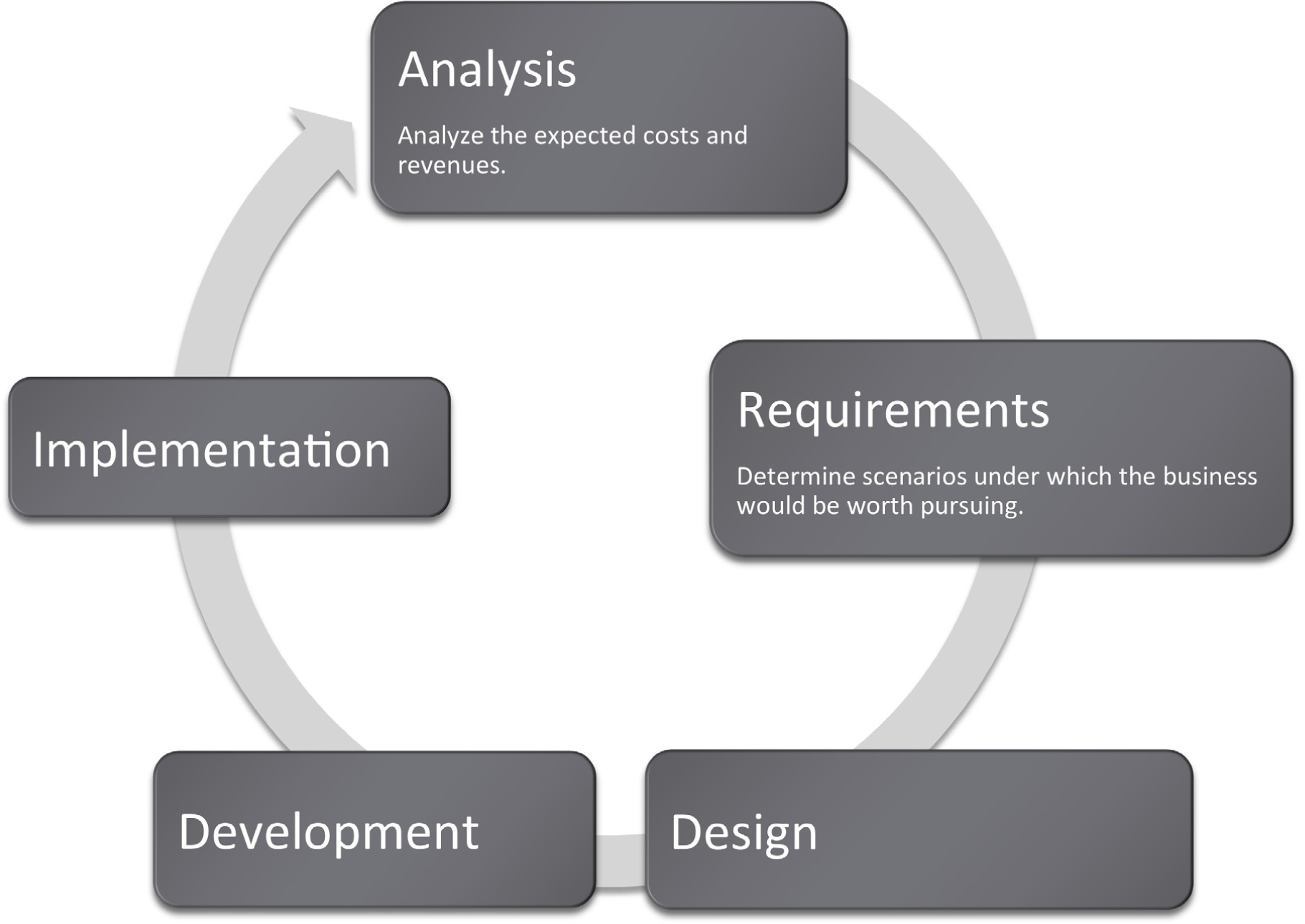
To actually program an iPhone app requires fairly extensive programming knowledge. Apps are programmed in a language called objective C. This is beyond the scope of most information systems (IS) business analystsThis is a job title typical for an IS graduate. Business analysts work both with business units such as Human Resources and the programmers. They discover the needs of the business unit and then translate those needs into documentation for the programmers. Business analysts also test the completed system and supervise its roll out.. IS professionals hire the programmers, rather than doing the coding themselves. In fact, most IS curricula teach programming only so that the business analyst is able to communicate effectively with programmers by speaking a bit of their language and understanding some of their constraints.
Within a large corporation there will typically be a team of developers (usually computer science majors) and a team of business analysts (usually IS majors). The business analysts communicate with the business units, such as marketing or finance, to analyze the business needs. They then translate those needs into requirements that are delivered to the developers. The process flows, mockups, and market descriptions that you have done in earlier chapters are all part of those requirements.
The developers program the application and then deliver it back to the business analysts for testing. In this way, IS professionals serve as the bridge between the developers and the business units.
The business analyst’s job continues even after the app is developed. They test the app extensively when it is delivered back from the developer.
Most of the iPhone apps with which you are familiar are designed for the consumer market. However, there are a number of corporations that design in-house proprietary iPhone apps for their employees. If you were designing your app for a company you would serve as the intermediary between the business unit and the developers.
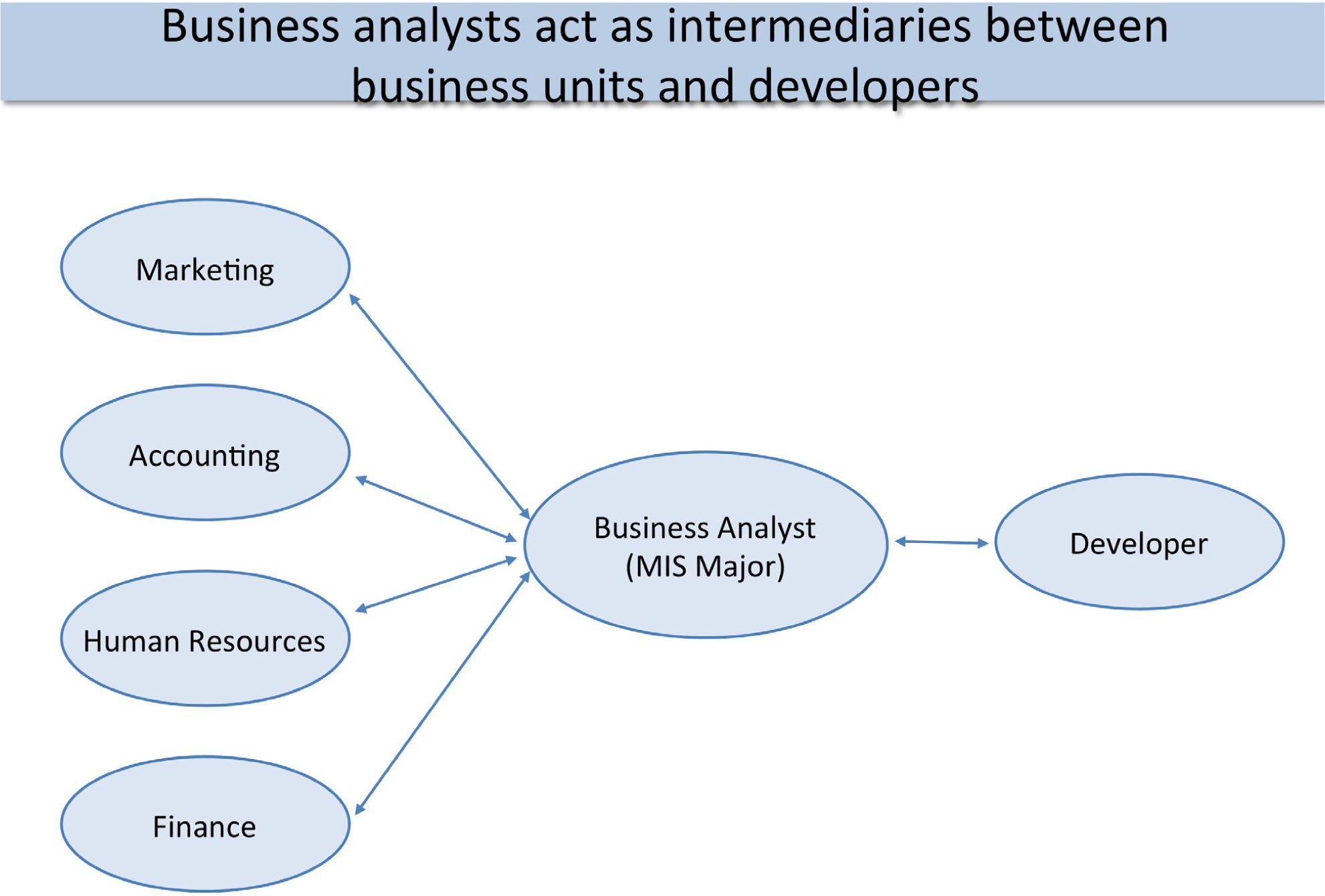
IS professionals typically serve in the role of a business analyst. They find out the requirements of the business unit and then translate those requirements into documentation that the programmers can work with.
Some corporations, especially small ones, do not retain a team of developers. They rely on the ability to contract out development work.
With the advent of the web, the process of locating programmers has become much easier. There are a number of portals such as Elance.com that allow you to auction off your job much the same way that you would auction a product on eBay. Developers then bid on your job and you select your preferred developer. To help you in the decision, these services also maintain ratings of developers based on feedback from prior clients.
The process of bidding out a job to a developer outside of your corporation is called outsourcingHiring another firm to do a job that traditionally might have been done in-house.. Outsourcing comes in two flavors depending on where the developer is located. Outsourcing to a local developer is called onshoringOutsourcing to a firm that resides in your own country.. Outsourcing to a developer in another country is called offshoringOutsourcing to a firm that resides in a foreign country.. Offshoring is a popular movement among North American companies due to the high cost of skilled labor in the United States. Many developers live offshore in countries such as India, Pakistan, Russia, and Brazil.
One key factor in outsourcing is communicating clearly with the developer. Any documentation that you prepare in advance helps reduce the possibility of misunderstandings. That is why we spent time planning the app and constructing a mockup.
Choosing a developer is not about getting the lowest price, but rather about getting the best value. You want a good developer, but maybe you do not need the best. Make sure that your developer has a reputation for delivering on time and within budget. Furthermore, you often get what you pay for. Cheaper developers may deliver lower quality.
There is a myth of developers in third world countries working practically for free. However, as countries such as India, Pakistan, and Russia become wealthier, the wages rise.
The offshoring process is imperfect and some U.S. companies have found that documentation requirements are so extensive, and communication problems so prevalent, that it is almost cheaper in the end to hire a local programmer somewhat familiar with the business already. Some portals, such as iPhoneAppQuotes.com, advertise on-shoring as their competitive advantageAn attribute that allows a firm to best the competition in some way..
Many companies provide iPhone quotes. Elance.com is more general and worldwide, developing lots of different kinds of systems with developers all over the world. iPhoneAppQuotes.com develops iPhone apps using only developers in the United States.
Sometimes students resist the process of estimating costs since there is so much uncertainty in the variables. Uncertainty is normal in business and is accepted by investors. The solution is to proceed with good faith estimates and perhaps produce a range of possible outcomes dependent on positive and negative scenarios.
Uncertainty implies risk. In the negative scenario, you might lose everything and go out of business. On the other hand, in the positive scenario, you might do very well. Fortunately, there are always people willing to take the risk to bring new products to market.
Below you will find a summary of the costs involved in creating an iPhone app. Note that we are not including the value of your time to conceive, document, and test the app. Like many entrepreneurs you will be working for free.
Legal costs: If your business has a name other than your own, then by law you must file for a Doing Business As (DBA)The cheapest way to start a business. It is just you doing business under another name. However, you are personally liable for business debts. license. However, that license does not protect you from liability. You are still personally liable for the debts of your business. A safer but more expensive option is to set up a Limited Liability Corporation (LLC)Usually the recommended way to start a small business. If the business goes under, you are not personally liable for the businesses debts.. The LLC offers some protection from personal liability. We are picking relatively inexpensive options though you may want to add the cost of an attorney to your estimates.
Developer costs: Your greatest cost will be to pay the developer. Avoid being too cheap here or the entire project will fail. To register and test your app with iTunes requires that you have an Apple Developer license. So even though you are not the developer, still you need to register as an Apple developerA developer registered with Apple. Only Apple developers can list apps on the iTunes store..
Marketing costs: Finally, you need to promote your app. You have already created a web site to which you can direct traffic. But ultimately people have to find out about you. App review sites such as AppVee.com offer advertising packages for around $200/month.
All of the above are fixed costsA cost that the business must pay whether or not they sell anything. Examples include rent, legal fees, development costs and so forth.. You have to pay them whether you sell one app or 10,000. However, you also have a variable costA cost that business incurs on each sale. For apps, the variable cost is the iTunes store commission. from Apple. Apple takes 30% of every sale on iTunes. This is for the privilege of selling your app in their store. Since they are the only store allowed to sell apps, you do not really have a choice. So if your app costs $2.00, Apple gets $0.60 for each app sold. You make $1.40 per sale.
What you make per unit after subtracting variable costs is called the contribution marginWhat you make on every sale after subtracting variable costs.. Knowing the contribution margin helps you quickly calculate your total revenue—simply multiply contribution margin by the number of units sold.
Table 7.1
| Various Fixed Costs | Amount | |
|---|---|---|
|
Doing Business As (DBA) or Limited Liability Corporation (LLC) license from a service such as LegalZoom.com |
$199 |
|
|
Outsourcing development from a portal such as Elance |
$3,500 |
|
|
Maintenance and updates from developer after year 1 |
$1,000/year |
|
|
Apple Developer license |
$99/year |
|
|
Ad on app review sites such as AppVee.com |
$2,400/year |
|
|
TOTAL FIRST YEAR |
$6,098 |
Some costs of doing business shown above. Legalzoom.com is one of the less expensive ways to incorporate.
The concept of variable costs is essential to predicting profitability. Put quite simply, you do not make any money unless you sell a lot of apps. Therefore, we will spend some effort trying to understand variable costs both conceptually and in a spreadsheet.
Notice the spreadsheets on the following page. The “before” spreadsheet is both sloppy and hard to read. The “after” spreadsheet uses contrast in fonts and size to focus attention on important information, and it uses alignment to create strength and clarity. Numbers and their headings are right justified, and the “Measure” category and its heading is left justified. Proximity and repetition of fonts create a professional finished look.
The “after” spreadsheet also includes three new columns: Years, Male Over/(Under), and Female earnings as a % of male earnings. These new columns are processed data or informationData that has been processed in a meaningful way.. Information summarizes or describes the data in a meaningful way. This information shows that disparity between male and female earnings both as an absolute value and as a percentage. To create information usually involves a formula. Formulas are written by the user to perform calculations on data. Business formulas tend to be simple, usually involving addition, subtraction, multiplication, or division. For example Male Over/(Under) subtracts female earnings from male earnings to show the difference between the two. Similarly female earnings as a percentage of male earnings divides female earnings by male earnings. Note that the information revealed by these columns tells us that there is a difference; it does not tell us why. And most information is very much like this. It needs to be interpreted in order to make business decisions, or in this case public policy decisions.
The total area of a spreadsheet often exceeds the normal width of printing paper. Address this problem by printing in landscape orientationPrinting horizontally rather than vertically on a piece of paper. The normal way to print is portrait or vertical orientation. and by scaling the page to the width of the paper.
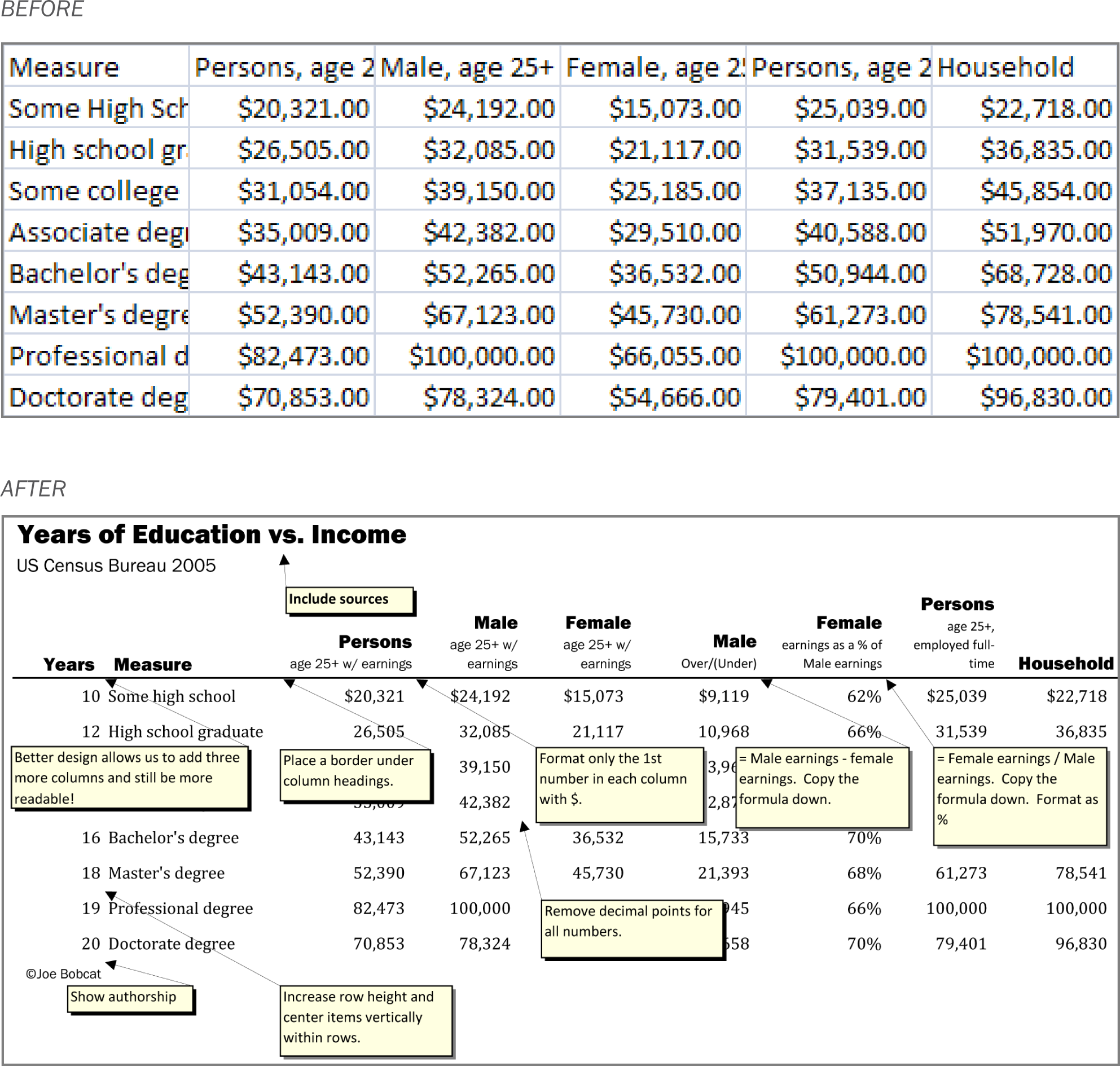
Formatting a spreadsheet makes an enormous difference as to its professionalism. Proper formatting also makes the data much more readable.
We mentioned previously that all forecasting involves making assumptions. These are educated guesses based upon research. However, assumptions may change over time. Ideally, you would like to be able to update your spreadsheet easily as the assumptions change. The easiest and most error free way to perform the updates is to use an assumptions area.
An assumptions areaA part of the spreadsheet, usually at the top, where the key variables are given their values. contains all of the variables that go into your calculations. It is normally located at the top of the spreadsheet. In a perfectly designed spreadsheet, the assumptions area is the only place that you actually type a number. Every other cell in the spreadsheet is a formula that refers back directly or indirectly to the assumptions area.
Consider the Apple Commission located in cell B7. We need to know the commission in order to calculate the contribution margin—how much we make on each sale. We would expect the contribution margin formulaA mathematical operation that normally references the values contained in other cells in the spreadsheet. If the cells are referenced by name, then their values will not change when copied. If the cells are referenced by location (e.g. B6), then the values will change when copied as Excel tries to guess a pattern. in B8 to reference B7. So the formula in B8 might look like this:
=B6*(1-B7)However, that formula is not particularly informative. The problem is that Excel does not know the meaning of the numbers in B7 and B8. It does not examine the labels to the left either. If we gave cells B6 and B7 meaningful names, we could calculate contribution margin as:
=PricePerUnit*(1-AppleCommission)or equivalently
=PricePerUnit-(PricePerUnit*AppleCommission)Note how these names are very similar to the labels. We say very similar because cell names can not contain spaces, whereas labels can. The cell names will be hidden from view but can be used in calculations as shown above.
The place where you create the names is in the name boxThe box located just above cell A1 . It is used to give names to spreadsheet cells. The names are variables, so they may not contain spaces. Also, remember to hit Enter after typing the name or it will not stick. on the toolbar just above cell A1. Simply type the name and hit Enter. You must hit Enter or the name will not stick.
Remember cell names can not contain spaces. So “Apple_Commission” is OK and so is “AppleCommission.” However, “Apple Commission” as two words with a space in between will not work. By the way, capitalizing the first letter of each word and eliminating the spaces between words (e.g., PricePerUnit) is called CamelBack notationVariable names created by capitalizing the first letter of each word and eliminating the spaces between words. for obvious reasons.
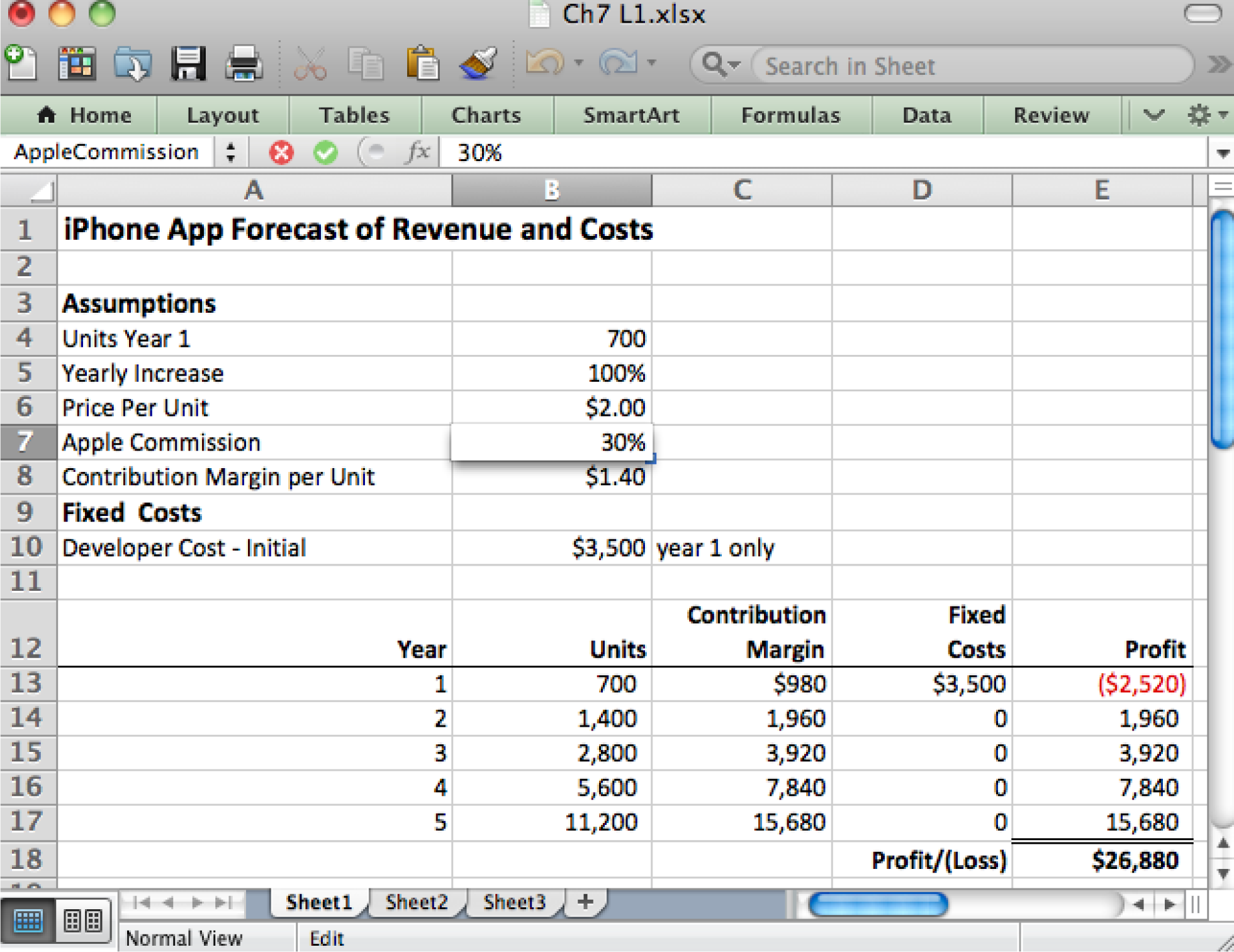
In a well designed spreadsheet the only place that numbers should be updated is in the assumptions area. Every other cell references the assumptions area using formulas.
Our last example showed a formula in the assumptions area. It is rare to have formulas in the assumptions area. Most formulas appear in the spreadsheet proper below the assumptions area.
Let us assume that we named B4 as UnitsYear1. Then the formula in B13 is =UnitsYear1. Every formula begins with an equal sign.
B14 is a much more interesting example, and one that shows the power of Excel. We are now in Year 2 and need to represent the projected increase in sales. To represent any increase involves taking the prior value (B13) and adding the increase to it. Calculate the increase by multiplying the prior value by the percentage increase. So we get:
=B13+B13*YearlyIncrease (700+700*100%)The first B12 is the prior value; the second B12*YearlyIncrease is the amount of the increase. The great thing about this formula is that it can be copied down to the rest of the cells in column B. Simply double click or drag the bottom right corner of B13 and the rest of the column will fill as follows:
B15: =B14+B14*YearlyIncrease (1400+1400*100%) B16: =B15+B15*YearlyIncrease (2800+2800*100%) B17: =B16+B16*YearlyIncrease (5600+5600*100%)Excel properly repeats the pattern without any further effort on your part! However, note carefully that this was only possible because we had earlier named B5 as YearlyIncrease. If we do not name B5 then the pattern would look like this:
B14: =B13+B13*B5 CORRECT (700+700*100%) B15: =B14+B14*B6 WRONG (1400+1400*$2.00) B16: =B15+B15*B7 WRONG (3200+3200*30%) B17: =B16+B16*B8 WRONG (5440+5440*$1.40)Excel improperly repeats the pattern moving every cell down one space each time. That is a problem for B5 in the assumptions area because the next cells down are Price Per Unit (B6=$2.00), Apple Commission (B7=30%), and Contribution Margin per Unit (B8=$1.40). These last three have nothing to do with units sold and we get gibberish instead of valuable information. What is even more frightening is that the numbers do not look obviously wrong.
So in addition to being more readable, naming cells in the assumptions area also protects us against errors when copying formulas.
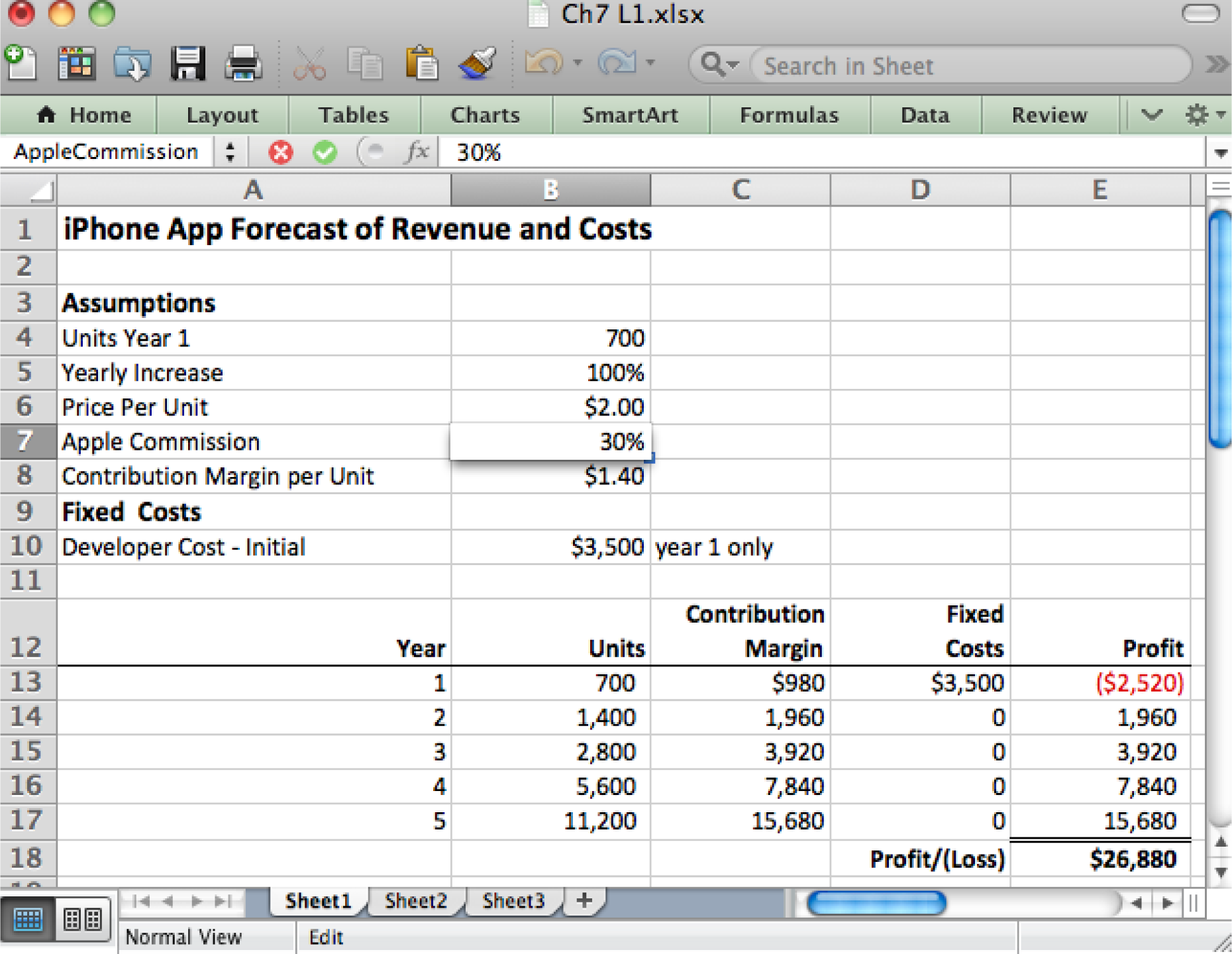
Above each cell in the assumptions area gets a unique name. For example, B7 is called AppleCommission (with no spaces allowed in the name). Below formulas in the calculation section reference values in the assumptions area by name. For example, the formula in B13 references the YearlyIncrease field. Such formulas may be copied down the column without fear that the formula will improperly change when copied.
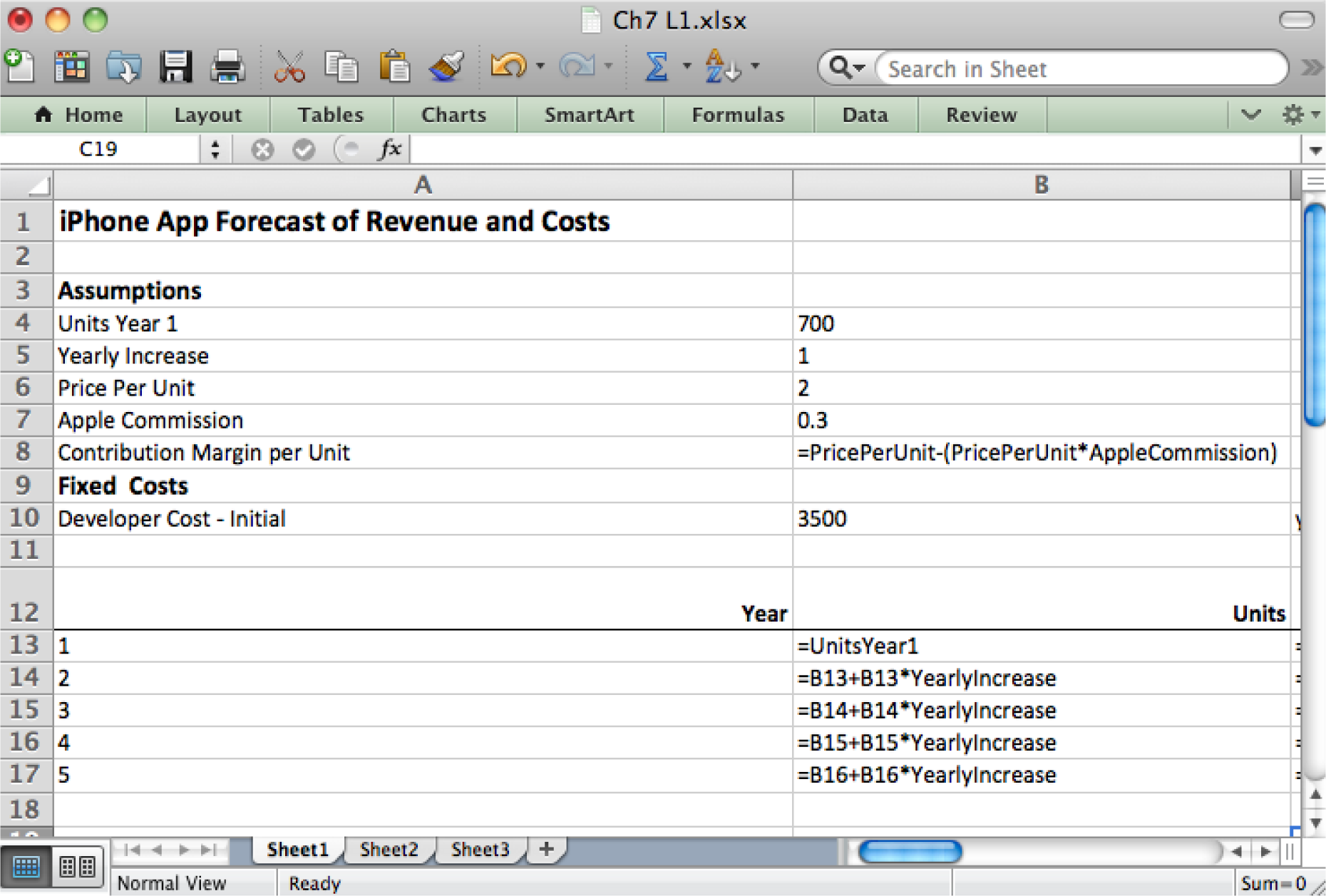
Any time you make assumptions, you have to allow for the possibility that you might be wrong. Since you are dealing with real money, some of which is probably yours or a relative’s, you need to know the extent of your exposure should things not work out as planned.
Therefore, it is a good idea to vary the assumptions and see what outcomes occur. This sophisticated analysis allows you to have an intelligent discussion about possible future scenarios.
A good way to conduct a sensitivity analysisAn analysis of how the outputs will change as the inputs from the assumptions area vary. You are literally trying to discover how sensitive the outputs are to changes in the inputs. The analysis helps determine how the inputs must be varied to achieve a desired result. is using an Excel data tableA tool used to perform a sensitivity analysis. A data table allows you to vary two of the inputs and record changes to one of the outputs. Amazingly the data table performs all of the computations for each combination of inputs.. A table can represent three variables—column headings, row headings, and the results inside the table. You vary the data in the row and column headings to observe changes inside the table. For example, assume that each cell inside the table contains the profit after Year 5. We can vary the growth rate and price per unit to see the effect on profit.
To perform these calculations without the data table would require manually changing growth rate and price per unit assumptions TWENTY times and recording the values after year 5—this is busy work. By contrast, Excel has the built in ability to create a data table.
The trickiest part of creating a data table is shown by the highlighted cells in the spreadsheet. You must repeat the value from your calculations on which you wish to perform the analysis. And not only do you have to repeat it, but you must repeat it using a simple formula. So the formula in B23 is:
B23: =E18Note how this cell must form the upper left corner of the data table. Now just fill in the row and column headings. We put various values for growth rate in the column headings and various values for price per unit in the row headings. Next highlight the whole table including the row and column headings and choose What If Analysis > Data Table. The last step is to identify for Excel the first cells where growth rate and price per unit appear in the assumptions area. Then Excel will substitute the values from the row and column headings into the assumptions area, redo ALL the calculations in the spreadsheet and then capture the results in the data table—all behind the scenes!
Now it is your job to argue for the ones you think are most favorable and realistic.
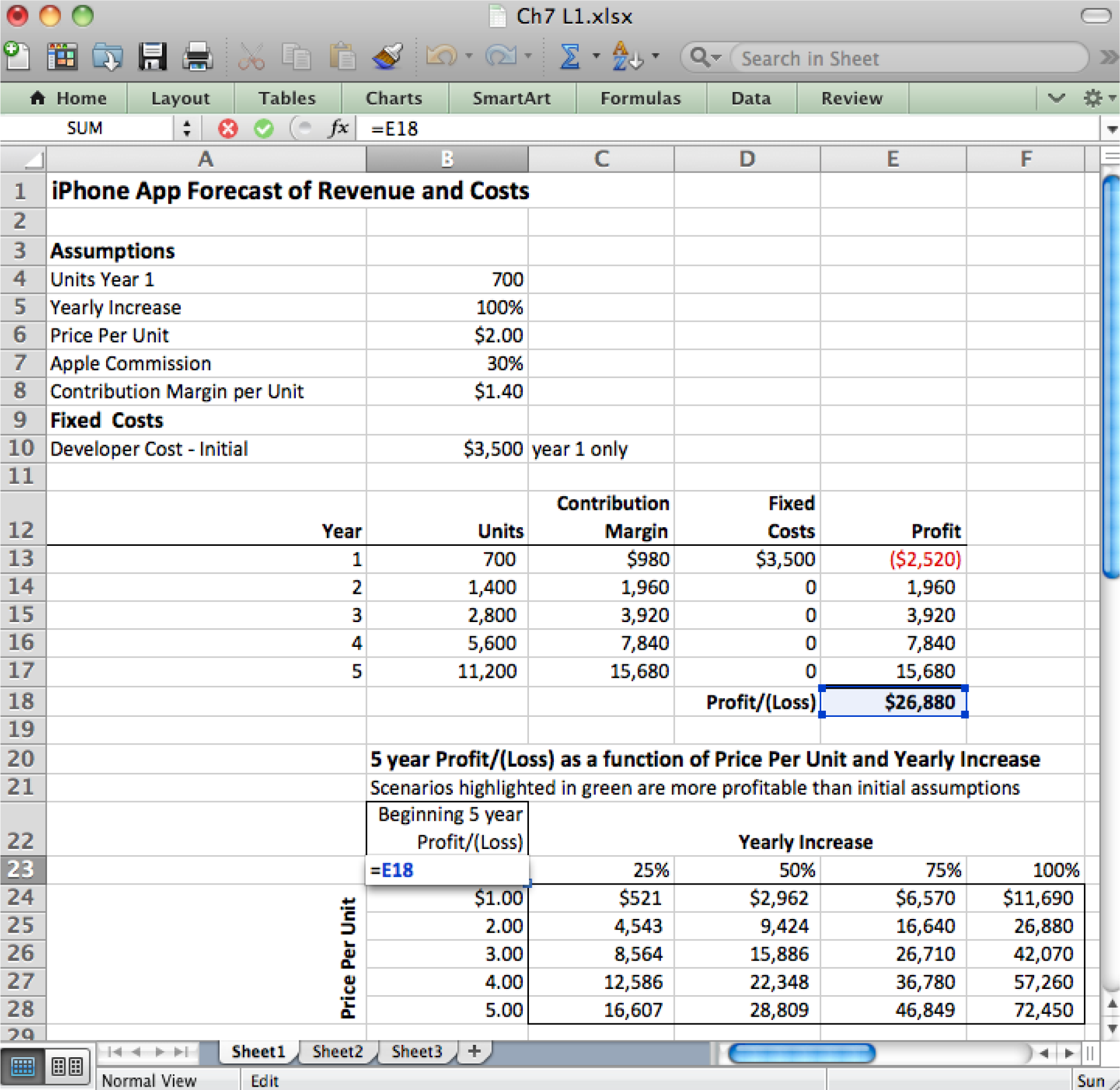
Make sure that the upper left corner of the data table is a simple formula that copies the value that you want to see varied in the data table.
The following techniques, found in the PowerPoint section of the software reference, may be useful in completing the assignments for this chapter: Overview Map of Interface • Cell Name-Create • Cell Name-Delete • Format Number • Formula-Copy • Formula-Create • Formula Mode • Insert Column • Insert Row • Move Decimal Point • Sensitivity Analysis
Professionals are able to represent what they know intuitively in a properly formatted spreadsheet with an assumptions area.
Setup
Start Excel and properly title your spreadsheet.
Content and Style
Deliverables
Electronic submission: Submit the workbook electronically.
Paper submission:
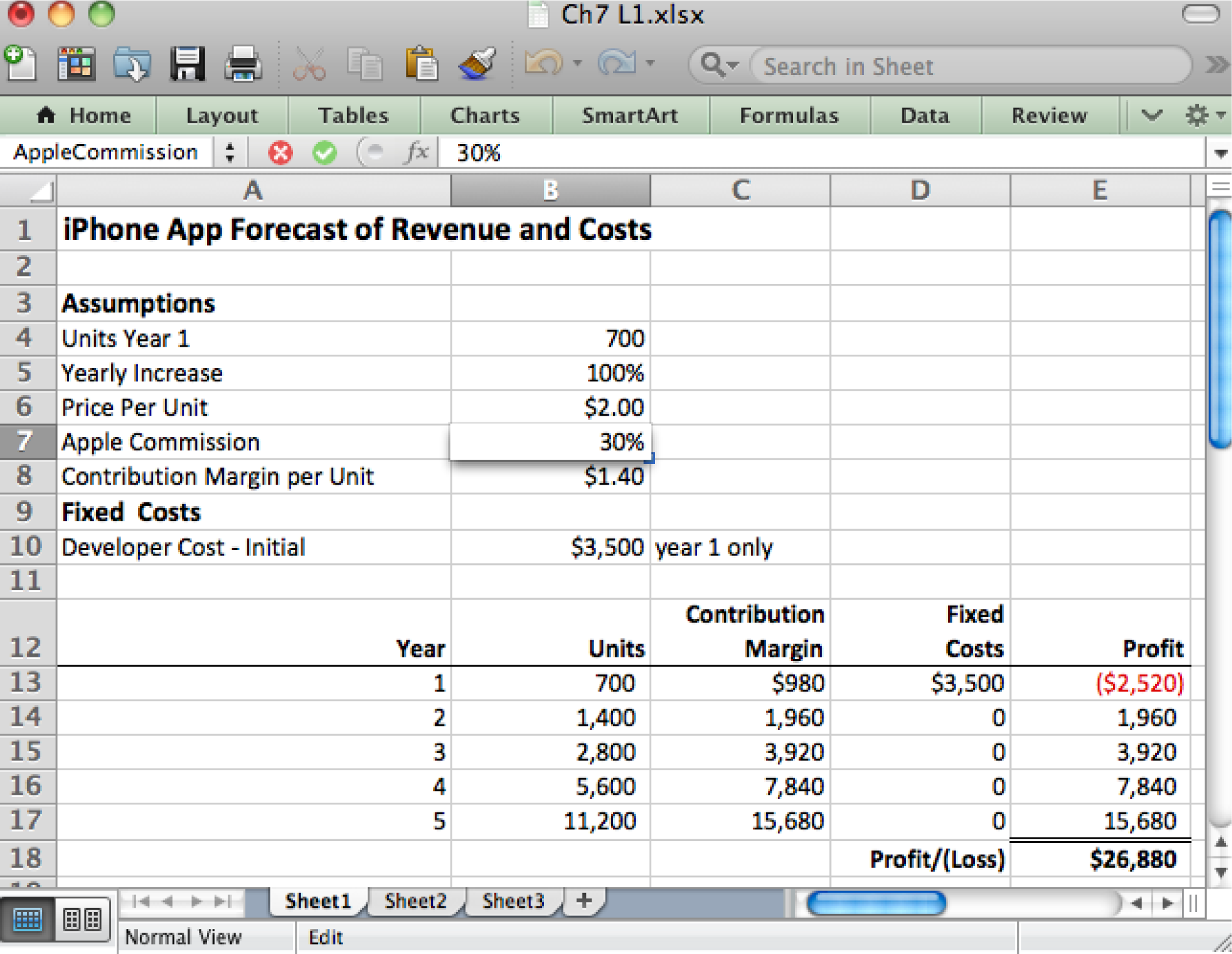
Please save the forecast revenues/costs spreadsheet; you will be updating it later.
To make the problem more realistic, we bring in additional fixed costs. To help in decision making, we perform a sensitivity analysis.
Setup
Re-save your workbook file from the L1 under a new name and then modify it to look as below. This must be a new workbook—do not simply create a new sheet in the same workbook or some of your names will conflict and spoil the data table.
Content and Style
Deliverables
Electronic submission: Submit the workbook electronically.
Paper submission:
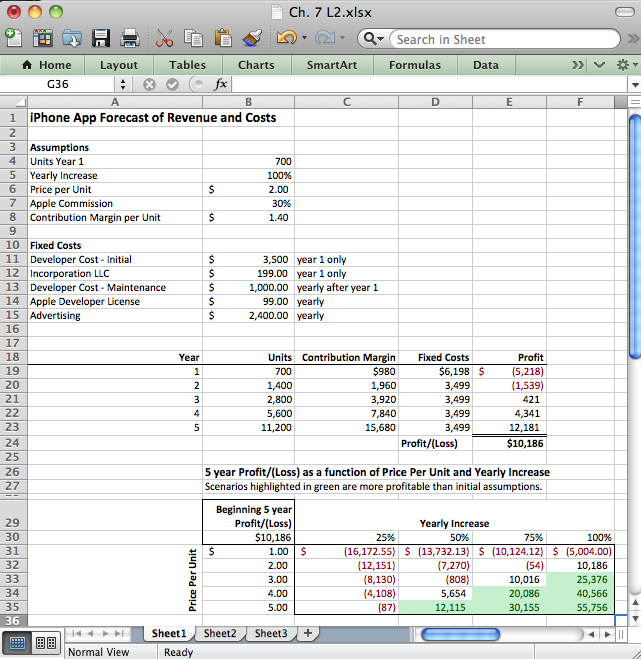
Add assumptions and columns as necessary to accommodate additional costs of maintenance, incorporation, and advertising.